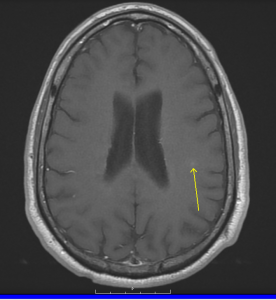Table of Contents
- 1 March is Multiple Sclerosis Awareness Month: Raising Awareness, Supporting Patients, and Promoting Hope
- 2 What is Multiple Sclerosis (MS)?
- 3 Common Symptoms of MS
- 4 Diagnosing MS
- 5 Treatment and Management of MS
- 6 Living with MS
- 7 Resources and Support for MS Patients and Families
- 8 Get Involved: Supporting MS Awareness Month
- 9 Neurological MRI Brain Scan
March is Multiple Sclerosis Awareness Month: Raising Awareness, Supporting Patients, and Promoting Hope

March is Multiple Sclerosis (MS) Awareness Month, a critical time to educate the public about this unpredictable disease, advocate for individuals affected, and support ongoing research efforts. Each year, organizations around the world amplify their efforts to raise awareness, support patients, and provide resources for families impacted by MS. At Greater Waterbury Imaging Center, we’re proud to join in these efforts to spread awareness and offer advanced diagnostic neurological imaging services to those affected by MS.
Learn more about activities during this awareness month by visiting MS Focus Awareness Month and the National MS Society’s awareness page.
What is Multiple Sclerosis (MS)?
Multiple sclerosis is a chronic autoimmune disease that impacts the central nervous system (CNS), affecting the brain and spinal cord. MS occurs when the body’s immune system mistakenly attacks the protective covering of nerve fibers, called myelin. This attack disrupts the normal communication between the brain and other parts of the body, causing unpredictable and often disabling symptoms.
MS is characterized by periods of relapse (new symptoms appearing or existing ones worsening) and remission (symptoms decreasing or disappearing). The disease can vary significantly from one person to another, with some experiencing mild symptoms, while others face significant disability.
Common Symptoms of MS
MS symptoms occur when the disease damages nerve pathways, interrupting or slowing communication between the brain and the body. Since the nervous system controls many bodily functions, symptoms vary widely, impacting physical, cognitive, and sensory functions.
MS symptoms vary widely, depending on which nerves are affected and the extent of damage. Common symptoms include:
- Fatigue: Persistent and debilitating tiredness, even after rest.
- Numbness or Tingling: Commonly occurring in limbs, face, or extremities.
- Difficulty Walking: Muscle weakness, balance issues, and coordination challenges.
- Vision Problems: Blurred or double vision, partial blindness, or pain with eye movement.
- Cognitive Impairment: Problems with memory, attention, and problem-solving.
- Emotional Changes: Depression, anxiety, irritability, and mood swings.
- Pain and Muscle Spasms: Chronic pain, muscle stiffness, and involuntary spasms.
For more detailed information on MS symptoms, visit Symptoms of MS.
Diagnosing MS
 Early and accurate diagnosis is vital in managing MS effectively. Diagnosing MS can be challenging, as symptoms often mimic other neurological disorders, such as Lyme disease, lupus, or vitamin deficiencies, making a comprehensive diagnostic evaluation essential. Physicians typically rely on a combination of clinical history, physical examinations, imaging studies, and laboratory tests to confirm an MS diagnosis. Common diagnostic methods include:
Early and accurate diagnosis is vital in managing MS effectively. Diagnosing MS can be challenging, as symptoms often mimic other neurological disorders, such as Lyme disease, lupus, or vitamin deficiencies, making a comprehensive diagnostic evaluation essential. Physicians typically rely on a combination of clinical history, physical examinations, imaging studies, and laboratory tests to confirm an MS diagnosis. Common diagnostic methods include:
- Magnetic Resonance Imaging (MRI): Advanced imaging techniques, like MRI brain scans offered at Greater Waterbury Imaging Center, provide detailed views of the brain and spinal cord, identifying lesions and inflammation that are characteristic of MS. MRI scans are essential because they can reveal areas of damage (plaques or lesions) caused by MS, even before symptoms become noticeable.
- Neurological Exams: Physicians conduct thorough neurological assessments to evaluate reflexes, coordination, balance, strength, vision, and sensory function. These examinations help determine whether there is neurological damage indicative of MS or other potential disorders.
- Spinal Tap (Lumbar Puncture): A spinal tap involves collecting cerebrospinal fluid (CSF) to look for abnormal antibodies and proteins associated with MS. This test can help differentiate MS from other neurological conditions and provide supporting evidence for the diagnosis.
- Evoked Potential Tests: These tests measure electrical signals sent by the brain in response to visual, auditory, or sensory stimuli. Delayed responses may indicate nerve damage consistent with MS.
These diagnostic tools allow healthcare providers to establish an accurate diagnosis, differentiate MS from other conditions, and develop an effective, personalized treatment plan.
Treatment and Management of MS
Although no cure for MS exists yet, various treatments help manage symptoms and slow the progression of the disease. Treatment goals include symptom management, minimizing disease activity, and maintaining the quality of life. Treatments commonly include:
- Disease-Modifying Therapies (DMTs): Medications such as oral treatments, injectables, and infusion therapies aimed at reducing relapse rates and slowing disease progression.
- Physical and Occupational Therapy: Programs designed to improve mobility, strength, coordination, and daily living skills.
- Lifestyle Management: A Healthy diet, exercise, stress management, and adequate sleep significantly benefit overall wellness and symptom management.
Learn more about the latest treatment options for MS at the Multiple Sclerosis Foundation, Treatment for MS.
Living with MS
Managing daily life with MS can be challenging, but with the right support systems and strategies, individuals can live fulfilling lives. It’s important to address:
- Mobility and Accessibility: Using mobility aids, adapting living spaces, and leveraging assistive technology.
- Cognitive and Emotional Support: Mental health counseling, cognitive rehabilitation, and emotional coping strategies.
Resources and Support for MS Patients and Families
Strong support networks are critical for those living with MS and their caregivers. Helpful resources include:
- Emotional and Peer Support Networks: Connect with others experiencing similar challenges through groups and forums.
- Educational Resources: Access comprehensive guides, toolkits, and patient education materials.
- Financial and Logistical Support: Assistance programs to help manage medical expenses, accessibility equipment, and daily living costs.
For support resources, visit the National MS Society: MS Support and MS Focus Get Involved.
Get Involved: Supporting MS Awareness Month
 You can actively support MS awareness by participating in local events, fundraisers, and advocacy efforts. Here’s how you can help:
You can actively support MS awareness by participating in local events, fundraisers, and advocacy efforts. Here’s how you can help:
- Raise Awareness: Share educational content, stories, and experiences on social media.
- Community Engagement: Participate in or host community events to promote understanding and inclusivity.
- Support Research and Advocacy: Donate or volunteer your time to organizations leading research, advocacy, and support initiatives.
Discover ways to participate by visiting the National MS Society Awareness Campaigns page.
March highlights the importance of MS awareness, but ongoing support, education, and advocacy are essential year-round. By increasing awareness, providing resources, and encouraging community involvement, we can significantly improve the lives of those living with MS.
Neurological MRI Brain Scan
 Greater Waterbury Imaging Center (GWIC) provides specialized neurological MRI brain imaging services to support the diagnosis and ongoing management of multiple sclerosis. Our advanced MRI technology delivers high-resolution images of the brain and spinal cord, enabling physicians to identify and monitor characteristic lesions associated with MS. Regular MRI scans are crucial for monitoring disease progression, evaluating treatment effectiveness, and adjusting therapies as needed to maintain optimal patient health.
Greater Waterbury Imaging Center (GWIC) provides specialized neurological MRI brain imaging services to support the diagnosis and ongoing management of multiple sclerosis. Our advanced MRI technology delivers high-resolution images of the brain and spinal cord, enabling physicians to identify and monitor characteristic lesions associated with MS. Regular MRI scans are crucial for monitoring disease progression, evaluating treatment effectiveness, and adjusting therapies as needed to maintain optimal patient health.
Learn more about GWIC’s neurological imaging services for MS, including brain and spinal MRI, by visiting our dedicated MRI Brain Scan page, with specific information on MRI for Multiple Sclerosis.
Greater Waterbury Imaging Center is committed to supporting patients with advanced neurological MR imaging services, which are crucial for the accurate diagnosis and effective management of MS. To learn more about our MRI services and schedule an exam, contact Greater Waterbury Imaging Center today.


